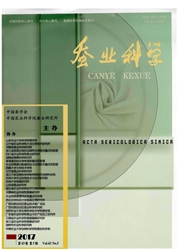

 中文摘要:
中文摘要:
为了解不同类型桑种质资源桑叶中多酚类物质的含量差异,分别采用福林-酚法和高效液相色谱法,对包含野生资源和栽培品种的7份桑种质资源桑叶中的总多酚含量以及15种单体酚类物质含量进行检测分析。结果表明:7份桑种质资源间的桑叶中的总多酚含量差异较大,变幅为7.84-17.28 mg/g,野生桑资源的桑叶中的总多酚含量普遍高于栽培品种,其中野生变种垂枝桑桑叶总多酚质量比为17.28 mg/g,显著高于其他桑种质资源的桑叶样品(P〈0.05),其次是野生鸡桑种的紫白4,其桑叶总多酚含量显著高于栽培品种育2号、大10和湘7920的桑叶样品(P〈0.05)。7份桑种质资源桑叶中的单体酚以绿原酸的含量最高,变幅为1.79-3.08 mg/g;其次是芦丁的含量,变幅为0.27-1.51 mg/g;含量最低的是咖啡酸,而阿魏酸和白藜芦醇均未检出。检测结果提示,野生桑资源桑叶中的多酚类物质含量更为丰富。
 英文摘要:
英文摘要:
In order to investigate the difference of polyphenol content in mulberry leaves from different germplasm re- sources, total polyphenols and 15 kinds of monomeric phenols of mulberry leaf from 7 mulberry germpalsm resources inclu- ding both wild resources and cultivars were determined by Folin-Ciocalteu method and HPLC analysis respectively. The re- sults showed great difference between total polyphenol contents in mulberry leaves from the 7 germplasm resources, with content variation from 7.84 to 17. 28 mg/g. Total polyphenol contents in mulberry leaves of wild resources were generally higher than those of cultivars, among which a variant of wild mulberry resources named Chuizhisang had a total polyphenol content of 17.28 mg/g, being significantly higher than that in mulberry leaf samples of other germplasm resources ( P〈 0.05). Another wild Morus australis variety named Zibai 4 had the second high total polyphenol content which was signifi- cantly higher than those of cultivars Yu 2, Da 10 and Xiang 7920 (P〈0. 05). Among the monomeric phenols of mulberry leaves, chlorogenic acid had the highest content, ranging from 1.79 to 3.08 mg/g in the 7 germplasm resources. Rutinhad the second high content, ranging from 0. 27 to 1.51 mg/g in the 7 germplasm resources. Caffeic acid had the lowest content, while no ferullic acid and resveratrol were detected. The results suggest that polyphenols in mulberry leaves from wild mulberry resources are richer than those from cultivars.
 同期刊论文项目
同期刊论文项目
 同项目期刊论文
同项目期刊论文
 期刊信息
期刊信息
